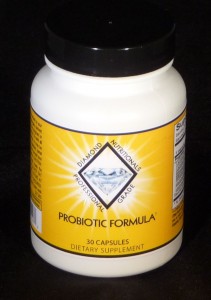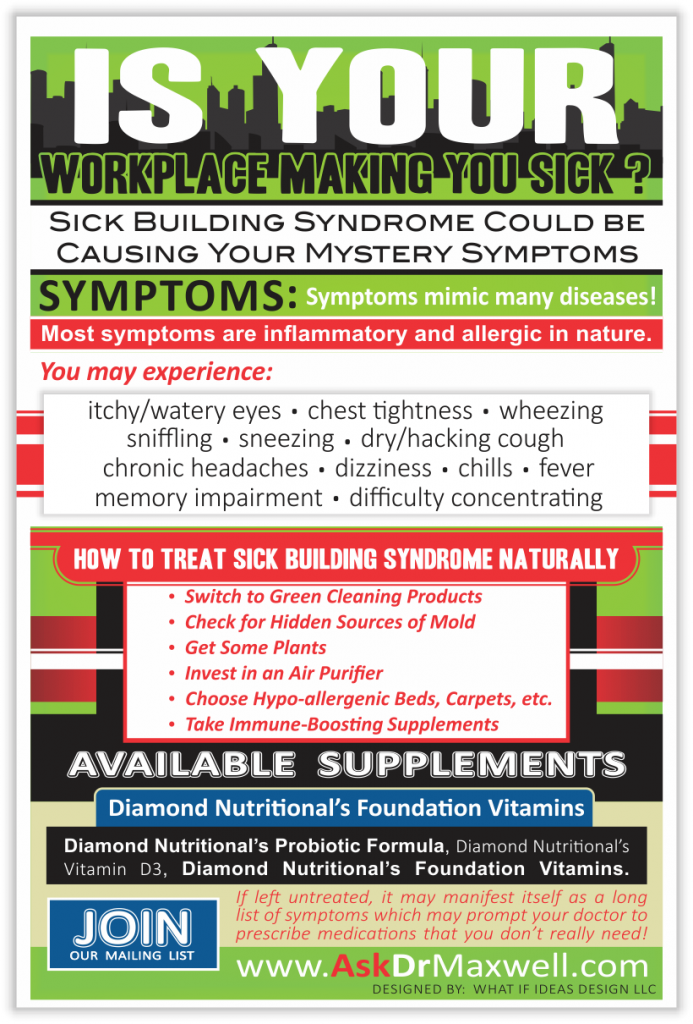by: Dr. Craig A. Maxwell

For the past 30 years, I have seen thousands of patients struggling with unexplained “mystery symptoms.” Unusual health problems that seemed to appear out of nowhere after purchasing a new home or taking on a new job. In my early years of practice, I believed that these sudden symptoms were sometimes stress-related. After all, major life changes can contribute to all sorts of unusual symptoms.
But after months or even years, these strange symptoms would continue, slowly deteriorating the quality of life for my patients. I tested for viral infections, autoimmune disease, and even chronic candida infection but results were inconclusive at best.
After a while, however, an interesting pattern began to emerge. When several of my patients went on vacation, their symptoms disappeared, only to return once they came back home.
Stress? No, I knew it had to be something deeper than that. After all, a few patients noticed an immediate improvement once they changed jobs. This indicated to me that something in their environment was causing these problems and I intended to find out what. After several months of research I found a term called “sick building syndrome.”
The oil embargo of the 1970s changed the way buildings were constructed by forcing companies to drastically reduce costs on office buildings. This resulted in the creation of “tight” buildings with windows that would no longer open to reduce heating and cooling costs.
The unfortunate side effect of buildings designed this way is fungi, mold, chemicals, cleaning products, photocopier ozone, cigarette smoke, new carpet fumes, pesticides sprayed by an exterminator, and even exhaled carbon dioxide, no longer have a means of escape.
They just circulate around and around and around where you continually breathe them in hour after hour, day after day.
Sick Building Syndrome at Home
Sick building syndrome isn’t just limited to your office space. Even though your home may be well-ventilated, you could still be at risk for a type of sick building syndrome called sick house syndrome. Household cleaning products, new flooring, new carpeting, new mattresses, paint fumes, and even hidden sources of mold could be making you sick.
Common Symptoms of Sick Building Syndrome

Sick building syndrome can be very difficult to pin down because it mimics so many different diseases. Most symptoms are inflammatory and allergic in nature. You may experience itchy, watery eyes, chest tightness, wheezing, sniffling, sneezing, and a dry, hacking cough. Other symptoms include chronic headaches, dizziness, chills, fever, memory impairment, and difficulty concentrating.
Due to the neurotoxic effect of many conventional cleaning products, which produce volatile organic compounds, sick building syndrome can also lead to anxiety, depression, mood swings, and even paranoia!
Is it Sick Building Syndrome?
The most tell-tale indicator of sick building syndrome is a reduction or cessation of symptoms when you’re away from your home or office for several days. If your symptoms vanish when you’re home or on vacation or they persist in certain areas of your home or office, you could be suffering from sick building syndrome.
Since you have so much to do and think about during the day, you might not even notice that you feel nauseous every night at 9pm (when you’re in your bedroom) or dizzy each time you close your office door.
Keep a small pad and pen with you and make a list of your symptoms, what time they happen, and where you were at the onset. This can work wonders in helping you narrow down the culprit(s) so you can finally make the connection between your environment and your symptoms.
How to Treat Sick Building Syndrome Naturally
Changing jobs or moving to a new home is rarely an option for someone with sick building syndrome. The good news is, even if you can’t get away from your environment, you can improve your surroundings and boost your immune system.
- Switch to Green Cleaning Products
Common household cleaning products contain dangerous chemicals such as parabens, phthalates, formaldehyde, bleach, and mercury that can wreck havoc with your health. The first step to healing from sickness and preventing more serious illness is to remove as many toxins from your immediate environment as possible.
Castile soap is an olive oil and essential oil-based soap that can be used as a household cleaner, body wash, shampoo, dish soap, laundry soap, and shaving cream all in one. Castile soap mixed with vinegar, lemon, and/or baking soda can clean and deodorize your home effectively without the need for potentially-harmful chemicals.
- Check for Hidden Sources of Mold
Mold allergies are very common and can often contribute to chronic allergy symptoms. Hidden sources of mold in your home are bathrooms, the basement, the attic, laundry rooms, and closets with water piping.
Do a thorough check of your home to check for hidden mold. If you find a patch or two, you can neutralize it with a solution of water and white vinegar. Be sure to wear gloves and a face mask when doing this. If you find an extensive amount of mold under your carpet or behind a wall, seek the help of mold experts.
- Open the Blinds
Opening the blinds in your home or office can really work to clean the air with natural negative ionization and UV waves.

- Get Some Plants
Natural, air-purifying plants not only boost your mood by bringing a bit of nature indoors, they also help ease the symptoms of sick building syndrome.
Here is a list of five air-purifying plants:
- Aloe – Aloe plants are succulent plants designed by nature to heal cuts, burns, and scrapes while clearing benzene and formaldehyde from the air.
- Spider Plant – Pretty and hardy, spider plants can filter benzene, formaldehyde, carbon monoxide and xylene from your home or office.
- Azalea – Attractive azalea plants do well in cooler weather, making them ideal for air-conditioned environments. These plants combat formaldehyde from plywood or foam insulation.
- Warneck Dracaena – The dracaena grows easily, without direct sunlight and helps to combat varnish and oil contaminants.
- Peace Lily – Peace lilies are fine with shade and only need weekly watering. For this limited investment, these pretty plants filter out volatile organic compounds, formaldehyde, benzene and trichloroethylene. The peace lily can even combat toluene and xylene.
- Invest in an Air Purifier
Even a small air filter in your home or office space can make a big difference in cutting down on your symptoms.
Here are a few of your options:
- Filters – Air purifying filters, also called air cleaners, are a part of your heating and cooling system. They remove contaminants from the air and prevent dust and dirt damage to your furnace.
- Ionizing – Ionizing filters use a small but intense electrical field of neutrally-charged ions to cause contaminant particles to clump together and fall to the floor.
- Adsorbants – Adsorbants (not absorbants), such as charcoal filters, trap and safely remove harmful contaminants from your environment.
- HEPA (High Efficiency Particulate Air) – HEPA filters are the Department of Energy Standard and remove harmful particles directly from the air.
- UV Light – UV Light filters use sterile micro-organisms to eliminate potential harm from airborne bacteria and particles.
- Choose Hypoallergenic Beds, Carpets, etc.
When selecting a new bed, carpet, flooring, etc. for your home, don’t just look into price and color. Also take into consideration what type of chemicals might be in these products as they can cause an intense allergic reaction. Products labeled hypoallergenic or “green” are your best bet.
- Take Immune Boosting Supplements
If you are prone to allergies, your immune system isn’t as strong as it could be. This is why it’s just as important to strengthen and stabilize your immune system as it is to detoxify your environment.
Here is what I recommend to my patients to boost their immune system and reduce their allergic symptoms:
Diamond Nutritional’s Foundation Vitamins

Even if you eat a healthy diet, you may still have some notable nutrition gaps due to poor soil quality and reduced nutrient levels.
This is why I recommend you take a high-quality multivitamin and mineral formula like Diamond Nutritional’s Foundation Vitamins (without iron).
It contains nutrients such as:
Vitamin A – 7,500 IU
Vitamin C – 500 mg
Vitamin D3 – 500 IU
Vitamin E – 100 IU
Vitamin K – 50 mcg
Thiamine – 25 mg
Riboflavin – 25 mg
Niacin – 25 mg
Vitamin B6 – 38 mg
Folic Acid – 400 mcg
Vitamin B12 – 500 mcg
Biotin – 200 mcg
Panthothenic Acid – 150 mg
Calcium – 100 mg
Iodine – 113 mcg
Magnesium – 200 mg
Zinc – 10 mg
Selenium – 100 mcg
Copper – 1 mg
Manganese – 2.5 mg
Chromium – 200 mcg
Molybdenum – 25 mcg
Potassium – 50 mg
Choline Bitartrate USP – 50 mg
Inositol – 50 mg
Mixed Tocopherols – 50 mg
Lipoic Acid – 25 mg
N-Acetyl-Cysteine USP – 25 mg
Rutin – 25 mg
Lutein – 3 mg
Boron – 1.5 mg
ProBiotic (regular)
Lycopene – 1 mg
Vanadyl Sulfate Hydrate – 1 mg
Diamond Nutritional’s Probiotic Formula

85% of your immune system is located in your gut. Adding Diamond Nutritional’s Probiotic Formula will give your immune system a boost while improving your overall digestive function. Unlike many store-bought probiotics which may contain as few as 1-3 billion single-strain bacteria, this probiotic formula contains 22 billion live, active colony forming units to repopulate your gut and build a strong defense against intestinal disease.
This complete formula contains lactobacillus acidophilus, lactobacillus paracasei, bifidobacterium lactis, bifidobacterium bifidum, lactobacillus plantarum, lactobacillus rhamnosus, saccharomyces boulardii.
Diamond Nutritional’s Vitamin D3 – 5,000 IUs
Over 85% of Americans are severely vitamin D3 deficient, leading to an increased susceptibility to a wide variety of disease and conditions. This is why I recommend you add Diamond Nutritional’s Vitamin D3 – 5,000 IUs to boost your immune system and prevent chronic conditions. Though many conventional physicians recommend taking 400 IUs per day, many recent studies have suggested that this amount is not nearly enough for most adults.

Sick building syndrome can be a very serious concern. If left untreated, it may manifest itself as a long list of symptoms which may prompt your doctor to prescribe medications you don’t really need.
Getting to the source of any health problem is much better than just covering up the symptoms. If sick building syndrome is a problem for you, these tips could be the solution you need to stay where you’re comfortable while naturally improving your health.










Wow! In the end I got a blog from where I be able to really get useful data
concerning my study and knowledge.
Thank you for the kind words!
Dr. Maxwell